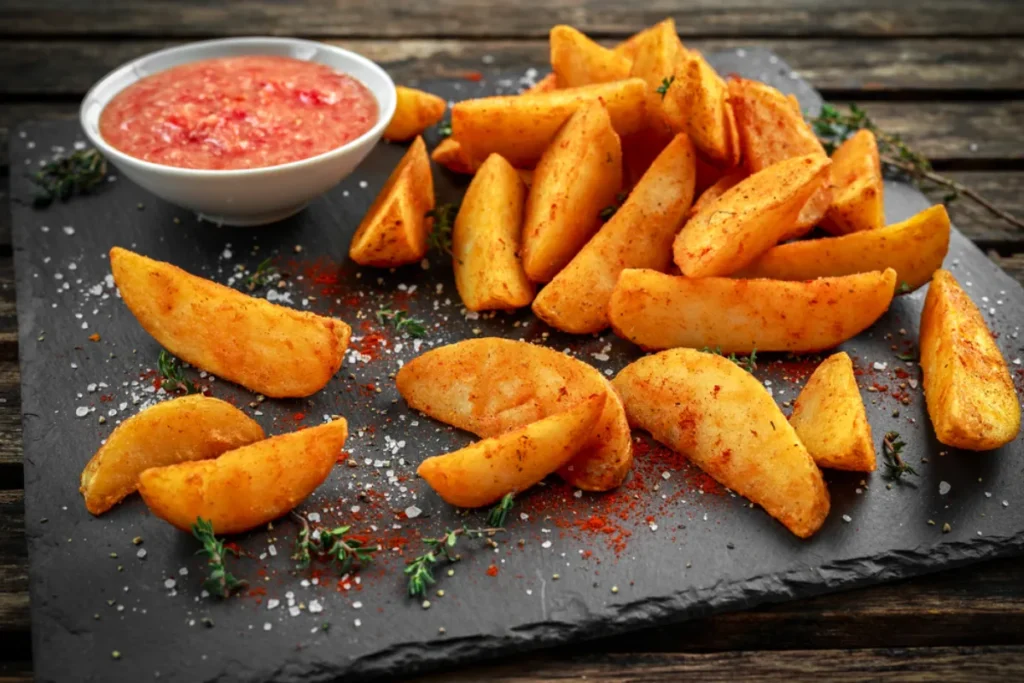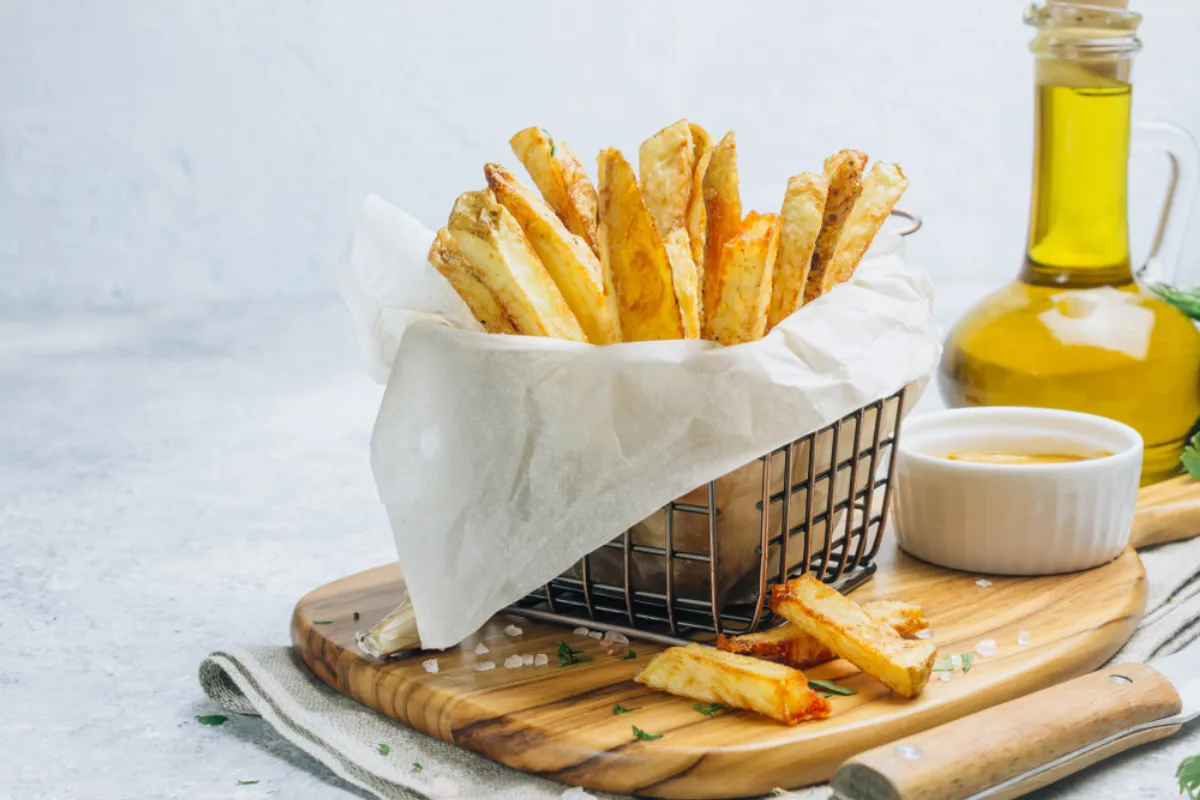Potatoes are one of the most versatile and universally loved foods, often transformed into a variety of dishes, including chips, fries, and wedges. While they all start from the same humble ingredient, these three dishes offer unique textures, flavors, and preparation methods. But what exactly sets them apart?
In this article, we’ll explore the difference between chips, fries, and wedges, examining how each is made, their distinctive characteristics, and when to serve them. Whether you’re cooking at home, hosting a gathering, or choosing a side at a restaurant, understanding these potato favorites will help you make the perfect choice.
1. What Are Chips?
Chips, also known as crisps in some countries, are thinly sliced potatoes that are fried or baked until they become crunchy. Known for their satisfying crunch and wide range of flavors, chips are often eaten as a snack or side dish. Unlike fries and wedges, chips are much thinner and typically enjoyed at room temperature.
How Chips Are Made
Making chips is all about achieving that perfect balance of crispiness and flavor. Here’s how they’re typically prepared:
- Slicing the Potatoes: The key to chips is slicing the potatoes as thinly as possible, often using a mandoline or food processor for even cuts.
- Frying or Baking: Traditional chips are deep-fried at high temperatures until golden brown and crispy. For a healthier option, they can also be baked in the oven, although they may not be as crispy as their fried counterparts.
- Seasoning: Chips are usually salted immediately after cooking while they’re still warm to allow the seasoning to stick. Various flavors can be added, including barbecue, cheese, or sour cream and onion.
Types of Chips
- Classic Potato Chips: Thin, crispy, and often lightly salted, these are the most common type of chips found in stores and served as a snack.
- Kettle Chips: These are thicker and fried in small batches, resulting in a heartier crunch compared to regular potato chips.
- Flavored Chips: From sour cream and onion to jalapeño and salt and vinegar, flavored chips add a unique twist to the basic recipe.
Serving Ideas for Chips
Chips are primarily eaten as a snack, but they also make a great side dish for sandwiches, burgers, and dips at parties. Their crunchy texture and variety of flavors make them a versatile option for any occasion. Unlike fries and wedges, chips are usually enjoyed cold, and their portability makes them a popular on-the-go snack.
2. What Are Fries?
Fries, also known as French fries, are perhaps the most iconic potato dish. They are long, thin slices of potato that are typically deep-fried until golden brown and crispy on the outside while remaining soft and fluffy on the inside. Fries are a staple in fast food and are often served with burgers, hot dogs, and sandwiches.
How Fries Are Made
The key to great fries lies in their preparation. Here’s how they’re traditionally made:
- Cutting the Potatoes: Fries are cut into long, thin strips, typically about 1/4 inch thick. Shoestring fries are thinner, while steak fries are thicker.
- Double Frying: For the crispiest fries, the potatoes are often fried twice. The first fry is done at a lower temperature to cook the potato through. The second fry, at a higher temperature, crisps up the outside, giving fries their signature texture.
- Seasoning: Fries are typically salted immediately after frying, though you can also add garlic powder, pepper, or herbs for extra flavor.
Types of Fries
- Shoestring Fries: These are ultra-thin and crispy, ideal for those who prefer a crunchier bite.
- Crinkle-Cut Fries: Known for their ridged shape, these fries offer a great balance of crunch and softness.
- Steak Fries: Thicker than regular fries, steak fries have a more substantial, soft interior.
- Curly Fries: These spiral-shaped fries are often seasoned with spices, giving them a bolder flavor.
Serving Ideas for Fries
Fries are commonly served as a side dish with burgers, sandwiches, and hot dogs. They can also be topped with cheese, chili, or gravy for heartier dishes like chili cheese fries or poutine. Their crisp texture and salty flavor make them a perfect companion for just about any casual meal. For extra indulgence, try dipping fries in ketchup, mayo, or aioli.
3. What Are Wedges?
Wedges are thick, chunky slices of potato, often with the skin left on. Unlike fries or chips, which are typically thinner and crispier, wedges offer a heartier, more substantial bite. They’re often seasoned with herbs and spices before being baked or fried. The thicker cut allows for a soft, fluffy interior, making wedges more filling than fries or chips.

How Wedges Are Made
Wedges are known for their robust flavor and texture. Here’s how they’re usually prepared:
- Cutting the Potatoes: Potatoes are cut into large wedges, usually by slicing them lengthwise into quarters or eighths. Leaving the skin on gives wedges extra texture and flavor.
- Baking or Frying: Wedges can be baked in the oven or fried. Baking is a popular method as it allows the potato to cook evenly while retaining its soft, fluffy interior.
- Seasoning: Wedges are typically seasoned with a mix of spices such as paprika, garlic powder, rosemary, and thyme. The seasoning is tossed with the wedges before cooking to ensure even flavor throughout.
Types of Wedges
- Classic Potato Wedges: These are thick-cut and generously seasoned with herbs and spices for a flavorful kick.
- Sweet Potato Wedges: A healthier, sweeter alternative, sweet potato wedges are often seasoned with cinnamon or cayenne for a sweet-and-spicy flavor profile.
- Spicy Wedges: For those who enjoy a bit of heat, spicy wedges are coated with chili powder, cayenne, or paprika before being baked or fried.
Serving Ideas for Wedges
Wedges are a great side dish for grilled meats, roasted vegetables, or even as a standalone snack. Their thicker size and bold flavor make them more filling than fries or chips, and they’re perfect for dipping in sauces like ketchup, barbecue sauce, or garlic aioli. Whether you’re serving them alongside a burger or enjoying them as a game-day snack, wedges offer a hearty alternative to other potato dishes.
Key Differences Between Chips, Fries, and Wedges
Now that we’ve explored how each type is made, let’s break down the key differences between chips, fries, and wedges.
1. Shape and Size
- Chips: Thin, round, or oval slices, usually less than 1/8 inch thick.
- Fries: Long, thin strips, typically 1/4 inch thick, though size can vary.
- Wedges: Thick, chunky slices, often with the skin left on, cut into quarters or eighths.
2. Cooking Method
- Chips: Typically fried at high temperatures for a crispy texture, though they can also be baked.
- Fries: Often double-fried to achieve a crispy exterior and a soft, fluffy interior.
- Wedges: Usually baked, though they can also be fried. Their thicker cut makes baking the preferred method to cook evenly.
3. Texture
- Chips: Super crispy with no soft interior.
- Fries: Crispy on the outside, soft on the inside.
- Wedges: Crispy edges with a soft, fluffy interior, offering a more substantial bite.
4. Flavor
- Chips: Lightly salted or flavored with seasonings such as barbecue or sour cream and onion.
- Fries: Typically salted but can also be flavored with garlic, cheese, or other spices.
- Wedges: Heavily seasoned with herbs and spices, creating a bolder flavor than fries or chips.
5. Best Served
- Chips: As a snack, often at room temperature.
- Fries: As a side dish with burgers, sandwiches, or topped with cheese and chili.
- Wedges: As a hearty side dish or snack, perfect for dipping in sauces or serving alongside grilled meats.
How to Choose Between Chips, Fries, and Wedges
Now that you know the difference between chips, fries, and wedges, how do you choose the right one for your meal or occasion?
- For a Light Snack: Chips are the best option for snacking. Their light, crispy texture makes them easy to eat on the go, and they come in a variety of flavors to suit any craving.
- For a Side Dish: Fries are the classic side dish. Whether you’re serving burgers, sandwiches, or hot dogs, fries complement just about any casual meal.
- For a Hearty Option: Wedges are more substantial and filling. Their thick cut and bold seasoning make them a great choice for a heartier side or standalone snack.
Conclusion:
While chips, fries, and wedges all come from the same beloved ingredient, each has its own unique qualities that make it special. Chips are thin, crispy, and perfect for snacking on the go, offering a light and crunchy bite in a variety of flavors. Fries, on the other hand, are the ultimate side dish, whether served alongside a burger, sandwich, or hot dog. Their crispy exterior and fluffy interior make them an all-time favorite. Finally, wedges provide a more substantial, hearty option, with thicker cuts of potato that are often heavily seasoned for bold flavor.
The key difference between chips, fries, and wedges lies in their shape, texture, and cooking methods, making each suitable for different occasions and cravings. Whether you’re looking for a crunchy snack, a savory side, or a filling treat, potatoes can be transformed into a dish that fits your needs perfectly.
Next time you’re choosing between these three, you’ll know exactly what to expect from each one and how to enjoy them to the fullest. From crispy chips to flavorful wedges, the versatility of potatoes means there’s always a delicious option to satisfy your taste buds.
FAQ
1. Are wedges healthier than fries?
Wedges are often baked rather than fried, which can make them a lighter option compared to fries, but both can be prepared in various ways.
2. Can I bake chips instead of frying them?
Yes! Chips can be baked at a high temperature to achieve a crispy texture, although they may not be as crispy as fried chips.
3. What’s the best dipping sauce for wedges?
Wedges pair well with sauces like garlic aioli, barbecue sauce, or a creamy ranch dip.
4. Why are fries often fried twice?
Double frying ensures the fries are cooked through and creates a crispy exterior while keeping the inside soft and fluffy.
5. Can I make sweet potato fries or wedges?
Absolutely! Sweet potatoes can be cut into fries or wedges and cooked using the same methods as regular potatoes.
